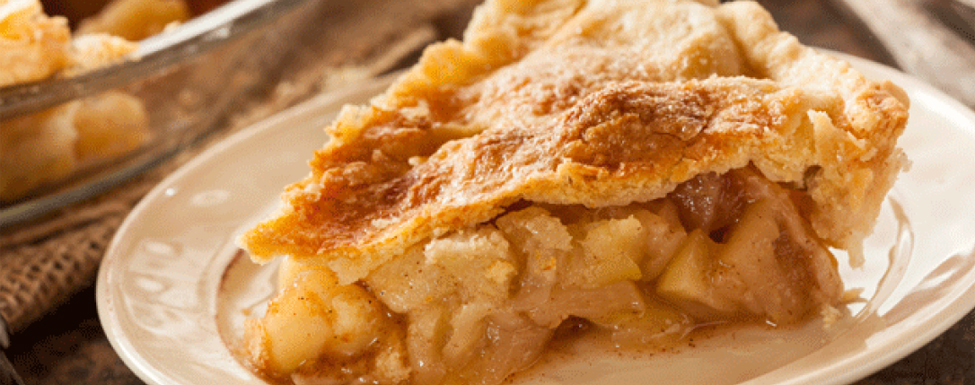Not Like Grandma Used to Make
It’s as American as apple pie. … Interesting concept as apples aren’t American at all—they were first imported to these shores by English settlers at Jamestown. What’s worse, early apples weren’t even meant for making pies. In the Elizabethan era, water was such a vector for disease cider was the preferred drink. One can assume that some Founding Fathers—John Adams enjoyed a tankard of hard cider for breakfast every morning—started their days half buzzed.
Apples of that era were astringent and bitter, perfect for cider, but had already been used in pies. As early as 1390, a recipe for apple pie was published in a cookbook compiled by Richard II’s master cooks. In a variation on today’s pie, the pastry—called unappetizingly a “coffin”—was not meant to be eaten.
For To Make Tartys in Applis
Tak gode Applys and gode Spryeis and Figys and reyfons and Perys and wan they are wel ybrayed colourd wyth Safron wel and do yt in a cofyn and do yt forth to bake well.
It may have been fit for a king, but it took nearly 500 years for the dessert to make its mark in the United States. Pies were always popular in New England, where settlers were drawn largely from East Anglia with its tradition of baked food. But because European wheat did not prosper in the early years, it was used for only the top pastry of the pie and often reserved only for company, yielding our reference to the “upper crust” of society.
By the 16th century, A Proper newe Booke of Cokyrye detailed the kind of pie that might have made it to American shores.
To make pyes of grene apples – Take your apples and pare them cleane and core them as ye wyll a Quince, then make youre coffyn after this maner, take a lyttle fayre water and half a dyche of butter and a little Saffron, and sette all this upon a chafyng dyshe tyll it be hoate then temper your flower with this sayd licuor, and the whyte of two egges and also make your coffyn and ceason your apples with Sinemone, Gynger and Suger ynoughe. Then putte them into your coffin and laye halfe a dyshe of butter above them and so close your coffin, and so bake them.
Clearly, the aroma of apple pie was as enticing as it is today, however. Robert Greene wrote in 1590, that he could think of no greater compliment to a young woman than that her “… breath is like the steame of apple-pyes.”
Even with the improvements in baking techniques, American pies left something to be desired in the 18th century. Dr. Israel Acrelius, author of the A History of New Sweden; or The Settlements On The River Delaware, writing home to Sweden in 1759, said, “Apple pie is used throughout the whole year, and when fresh Apples are no longer to be had, dried ones are used. It is the evening meal of children. House pie, in country places, is made of Apples neither peeled nor freed from their cores, and its crust is not broken if a wagon wheel goes over it.”
It is contended by one source, John T. Edge’s Apple Pie: An American Story, that Civil War stringencies promoted the pies’ popularity. He writes, “During the Civil War, both Union and Confederate troops scavenged for apples and commandeered the hearths—and flour bins—of white farmers and black tenants to bake pies. Wartime adversity fixed the taste of apple pie on the palate of generations to come.”
Richard II’s chef would be astounded by the variety of Tartys in Applis available today. Crusts may be traditional—but no longer impervious to wagon wheels—or non-traditional. Jason Young, owner of Sweet William’s in Salisbury, details a “groaning board” kind of pie created in his kitchens that starts with a sweet French pastry made of butter, sugar eggs and flour. The pastry is filled with apples, sugar, cinnamon, nutmeg and more butter, and covered with a crumb topping composed of sugar and molasses, flour, oats, ginger and, yes, yet more butter.
For more information about the delicacies at Sweet Williams, please visit the link below.


